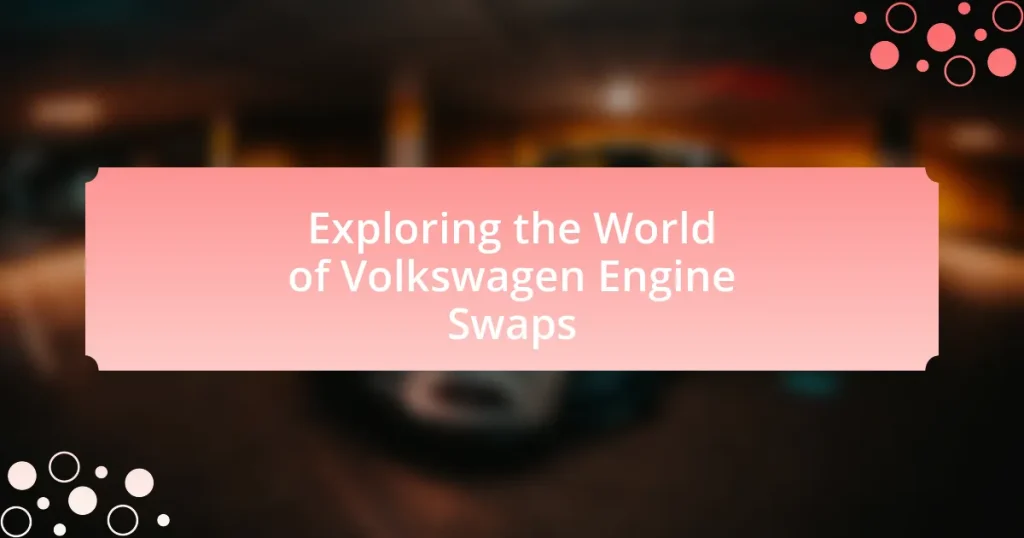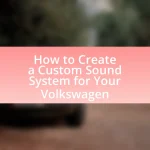Volkswagen engine swaps involve replacing the original engine of a Volkswagen vehicle with a different engine, often for enhanced performance, reliability, or customization. This article explores the complexities of engine swaps compared to standard replacements, detailing key components, the process involved, and the popular engine choices among enthusiasts. It also addresses the challenges and considerations, including legal regulations, technical skills required, and the impact of different Volkswagen models on swap options. Additionally, it highlights available resources and best practices to ensure a successful engine swap experience.
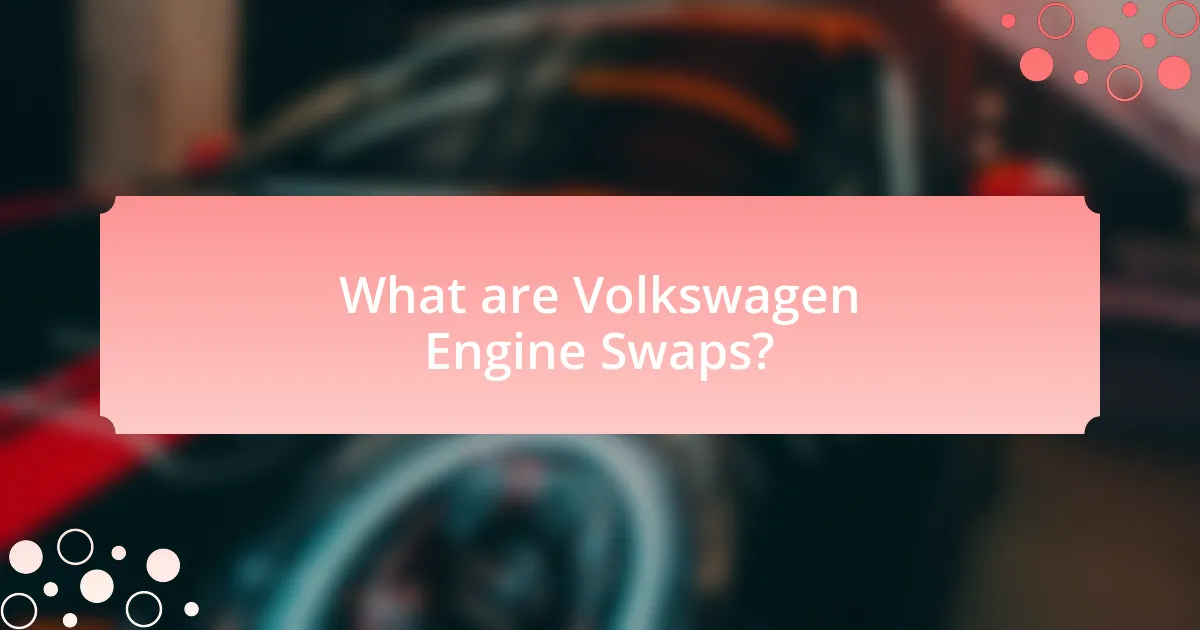
What are Volkswagen Engine Swaps?
Volkswagen engine swaps involve replacing the original engine of a Volkswagen vehicle with a different engine, often from another Volkswagen model or a compatible aftermarket engine. This practice is popular among automotive enthusiasts seeking improved performance, reliability, or unique customization options. Engine swaps can enhance horsepower, torque, and overall driving experience, making them a favored modification in the Volkswagen community. The process typically requires technical knowledge and may involve modifications to the vehicle’s wiring, mounts, and exhaust systems to accommodate the new engine.
How do Volkswagen engine swaps differ from standard engine replacements?
Volkswagen engine swaps differ from standard engine replacements primarily in their complexity and customization options. While standard engine replacements typically involve removing a failed engine and installing a direct replacement with minimal modifications, Volkswagen engine swaps often require significant alterations to accommodate different engine types, such as upgrading to a more powerful engine or changing engine configurations. This process may involve custom mounts, wiring harness modifications, and adjustments to the vehicle’s electronics, which are less common in standard replacements. Additionally, Volkswagen enthusiasts frequently pursue engine swaps to enhance performance or achieve specific goals, making these swaps more tailored and intricate compared to standard engine replacements that focus solely on restoring functionality.
What are the key components involved in a Volkswagen engine swap?
The key components involved in a Volkswagen engine swap include the engine itself, engine mounts, transmission, wiring harness, ECU (Engine Control Unit), fuel system, and exhaust system. The engine serves as the primary power source, while engine mounts secure it to the chassis. The transmission connects the engine to the drivetrain, allowing power transfer. The wiring harness integrates electrical connections, and the ECU manages engine functions. The fuel system supplies fuel to the engine, and the exhaust system directs emissions away from the vehicle. Each component is essential for ensuring compatibility and functionality in the engine swap process.
How does the process of swapping an engine work in Volkswagen vehicles?
Swapping an engine in Volkswagen vehicles involves several key steps: removing the old engine, preparing the new engine, and installing it. First, the vehicle must be securely lifted, and all necessary components such as the battery, exhaust system, and wiring harness are disconnected. Next, the old engine is unbolted from the transmission and removed from the engine bay. The new engine is then prepared, which may include transferring components like the intake and exhaust manifolds. Finally, the new engine is installed by reversing the removal process, ensuring all connections are secure and fluids are topped off. This process is supported by Volkswagen’s service manuals, which provide detailed specifications and procedures for various models.
Why are Volkswagen engine swaps popular among enthusiasts?
Volkswagen engine swaps are popular among enthusiasts primarily due to the significant performance enhancements they offer. Enthusiasts often seek to increase horsepower and torque beyond factory specifications, and engine swaps allow for the integration of more powerful engines, such as the VR6 or turbocharged options, into various Volkswagen models. This practice is supported by a robust aftermarket community that provides parts, resources, and knowledge, making it easier for enthusiasts to undertake these modifications. Additionally, the versatility of Volkswagen platforms, such as the Beetle and Golf, enables a wide range of engine compatibility, further driving interest in swaps.
What performance benefits can be gained from a Volkswagen engine swap?
A Volkswagen engine swap can significantly enhance vehicle performance by increasing horsepower and torque, improving acceleration, and optimizing fuel efficiency. Swapping to a more powerful engine, such as a turbocharged variant, can yield gains of 50% or more in horsepower compared to stock engines. Additionally, modern engines often feature advanced technologies that improve combustion efficiency, leading to better fuel economy. For example, a swap from a stock 2.0L engine to a 1.8T turbo engine can provide a substantial boost in performance metrics, making the vehicle more responsive and enjoyable to drive.
How does a Volkswagen engine swap enhance customization options?
A Volkswagen engine swap enhances customization options by allowing enthusiasts to replace the factory engine with a more powerful or efficient alternative, thereby tailoring performance to specific preferences. This flexibility enables modifications such as increased horsepower, improved fuel efficiency, or the integration of modern technology, which can significantly alter the driving experience. For instance, swapping a stock air-cooled engine for a turbocharged water-cooled engine can provide substantial performance gains, appealing to those seeking a sportier ride. Additionally, the extensive aftermarket support for Volkswagen models means that a wide variety of engines, including those from different Volkswagen Group brands, are readily available, further expanding customization possibilities.
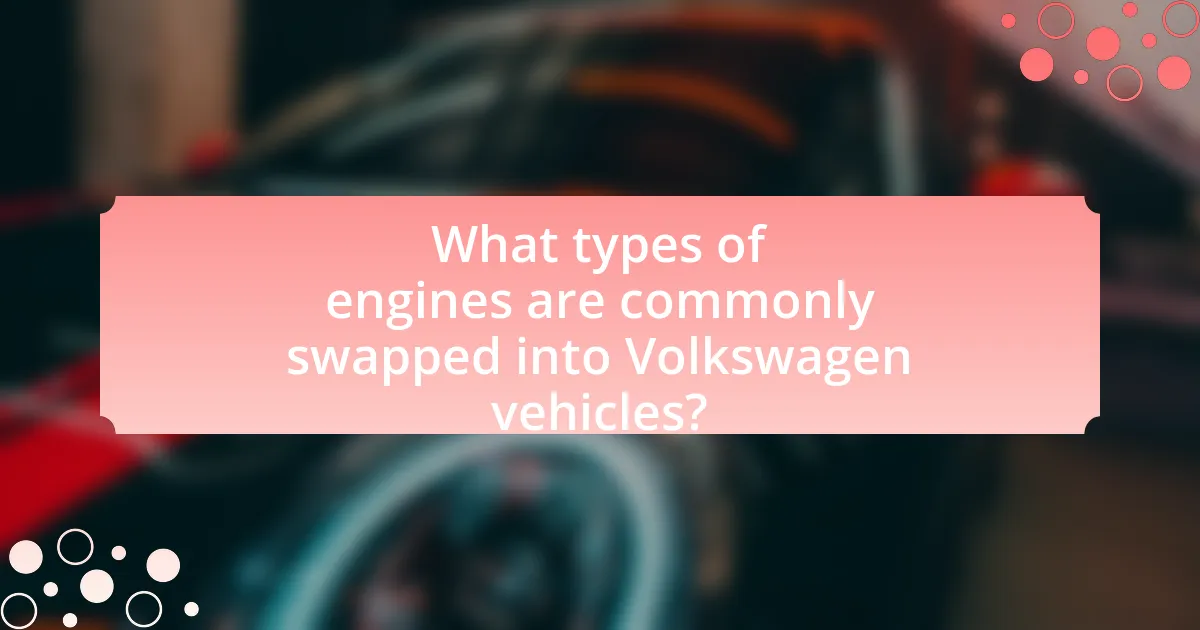
What types of engines are commonly swapped into Volkswagen vehicles?
Common engine swaps into Volkswagen vehicles include the 1.8T, VR6, and TDI engines. The 1.8T engine, a turbocharged inline-four, is popular for its balance of power and efficiency, often found in models like the Golf and Jetta. The VR6 engine, known for its unique design and smooth power delivery, is frequently swapped into older models for enhanced performance. The TDI engine, a turbocharged diesel option, is chosen for its fuel efficiency and torque, making it a preferred choice for those looking to improve mileage in models like the Passat. These swaps are supported by a robust aftermarket community, providing parts and resources for enthusiasts.
What are the most popular engine choices for Volkswagen swaps?
The most popular engine choices for Volkswagen swaps include the 1.8T, VR6, and Subaru EJ series engines. The 1.8T, a turbocharged inline-four engine, is favored for its balance of power and efficiency, producing up to 180 horsepower in stock form. The VR6 engine, known for its unique narrow-angle design, offers a smooth power delivery and can produce between 174 to 280 horsepower, making it a popular choice for performance enthusiasts. The Subaru EJ series engines, particularly the EJ20 and EJ25, are also commonly swapped due to their reliability and turbocharged options, providing significant power gains and all-wheel-drive compatibility. These engine choices are supported by a robust aftermarket community, ensuring availability of parts and support for installation.
How does the choice of engine impact performance and reliability?
The choice of engine significantly impacts both performance and reliability in vehicles. Different engines offer varying power outputs, torque characteristics, and efficiency levels, which directly influence acceleration, handling, and fuel consumption. For instance, a turbocharged engine typically provides higher power and torque compared to a naturally aspirated engine of the same displacement, enhancing performance metrics such as speed and responsiveness.
Reliability is also affected by engine choice; engines designed with robust materials and advanced engineering tend to have longer lifespans and require less maintenance. For example, engines from reputable manufacturers often undergo rigorous testing, resulting in lower failure rates and better overall durability. In contrast, engines that are not well-engineered or lack proper maintenance can lead to frequent breakdowns and costly repairs.
Statistical data supports this, as studies show that vehicles with high-performance engines often experience higher wear and tear, necessitating more frequent maintenance compared to standard engines. Thus, selecting the right engine is crucial for optimizing both performance and reliability in any vehicle, including those involved in Volkswagen engine swaps.
What are the pros and cons of using aftermarket engines versus OEM engines?
Aftermarket engines offer customization and potentially lower costs, while OEM engines provide reliability and compatibility. Aftermarket engines can be tailored for performance enhancements, allowing enthusiasts to achieve specific power outputs or efficiency goals. However, they may lack the same level of quality assurance and warranty coverage that OEM engines provide, which are designed to meet manufacturer specifications and ensure optimal performance in the vehicle. Additionally, OEM engines typically have better resale value and are easier to install due to their compatibility with existing vehicle systems. Conversely, aftermarket engines may require modifications to fit properly, leading to increased installation complexity and costs.
How do different Volkswagen models affect engine swap options?
Different Volkswagen models significantly affect engine swap options due to variations in engine compatibility, chassis design, and electronic systems. For instance, the Volkswagen Golf and Jetta have different engine bay dimensions and mounting points, which can limit the types of engines that can be swapped in without extensive modifications. Additionally, models like the Beetle and Passat may require custom mounts and wiring harnesses due to their unique layouts and electronic control units. Historical data shows that the popularity of certain engines, such as the 1.8T and VR6, varies by model, influencing the availability of aftermarket support and parts for swaps. Thus, the specific Volkswagen model dictates the feasibility and complexity of engine swaps, impacting both performance outcomes and project costs.
What considerations should be made for air-cooled versus water-cooled models?
Air-cooled models typically require less maintenance and are simpler in design compared to water-cooled models, which offer better thermal efficiency and performance. Air-cooled engines rely on airflow for cooling, making them lighter and easier to install, but they can overheat in high-stress situations. In contrast, water-cooled engines utilize a liquid cooling system that maintains optimal operating temperatures, enhancing performance and longevity. However, water-cooled systems are more complex, requiring additional components like radiators and hoses, which can complicate installation and increase maintenance needs.
How does the year of the Volkswagen model influence engine compatibility?
The year of a Volkswagen model significantly influences engine compatibility due to changes in design, technology, and regulations over time. For instance, models produced before 1990 often feature simpler mechanical systems, allowing for easier swaps with older engines, while models from 1990 onward typically incorporate more advanced electronics and engine management systems that complicate compatibility. Additionally, emissions regulations introduced in the 1990s necessitated changes in engine design, making it challenging to swap engines between models from different decades without significant modifications. Therefore, understanding the specific year of a Volkswagen model is crucial for determining which engines can be effectively swapped without extensive alterations.
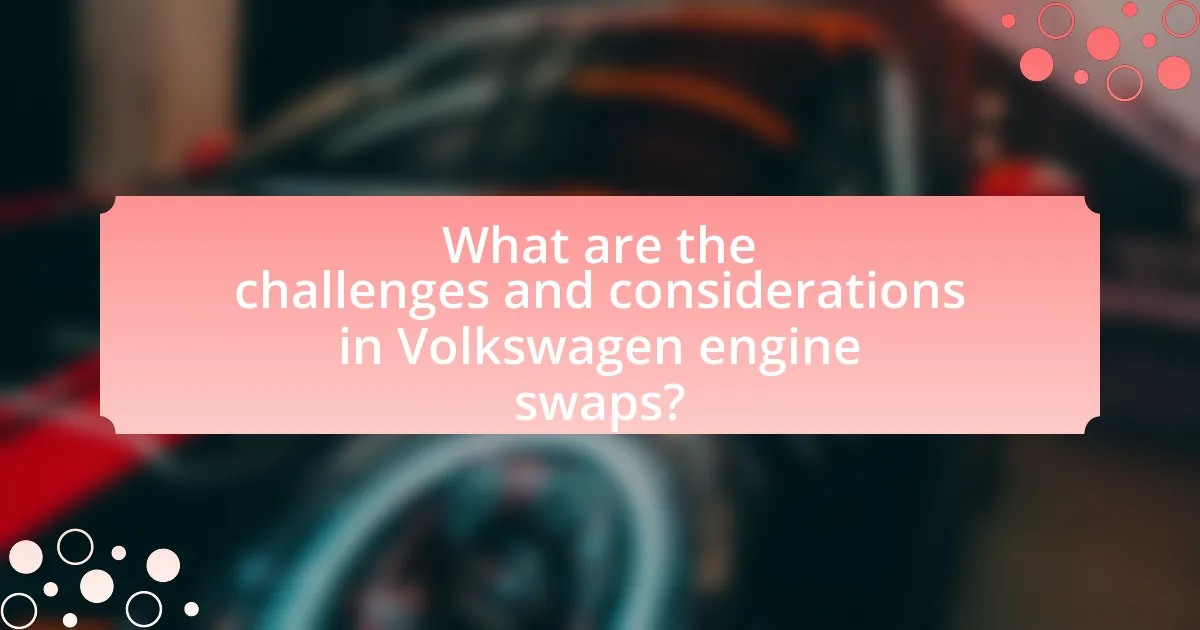
What are the challenges and considerations in Volkswagen engine swaps?
Volkswagen engine swaps present several challenges and considerations, primarily related to compatibility, legal regulations, and technical expertise. Compatibility issues arise from the need to ensure that the new engine fits within the existing engine bay and integrates with the vehicle’s transmission and electrical systems. Legal regulations can vary by region, requiring emissions compliance and inspections, which may complicate the swap process. Technical expertise is crucial, as improper installation can lead to performance issues or safety hazards. Additionally, sourcing parts and ensuring they meet quality standards can be challenging, impacting the overall success of the engine swap.
What legal and regulatory issues should be considered during an engine swap?
During an engine swap, legal and regulatory issues include compliance with emissions standards, vehicle registration requirements, and safety regulations. Emissions standards vary by state and country, necessitating that the new engine meets local environmental regulations to avoid fines or penalties. Vehicle registration may require documentation proving the engine swap was performed legally, including receipts and possibly inspections. Additionally, safety regulations must be adhered to, ensuring that the vehicle remains roadworthy and complies with safety standards set by authorities. Failure to address these issues can result in legal repercussions, including fines or the inability to register the vehicle.
How can emissions regulations impact the choice of engine for a swap?
Emissions regulations significantly influence the choice of engine for a swap by restricting the types of engines that can be legally installed in vehicles. These regulations often require that swapped engines meet specific emissions standards, such as those set by the Environmental Protection Agency (EPA) in the United States or similar bodies in other countries. For instance, if a Volkswagen owner wishes to swap an older engine for a newer one, they must ensure that the new engine complies with current emissions standards, which may limit options to newer, cleaner engines that utilize advanced technologies like turbocharging or hybrid systems. Failure to comply with these regulations can result in fines, failed inspections, and the inability to register the vehicle.
What documentation is required for a legal engine swap?
For a legal engine swap, the required documentation typically includes a bill of sale for the new engine, proof of ownership for the vehicle, and any necessary emissions compliance certificates. Additionally, some jurisdictions may require an inspection report from a certified mechanic to ensure the swap meets safety and regulatory standards. These documents are essential to verify the legality of the engine swap and to comply with local laws regarding vehicle modifications.
What technical skills are necessary for a successful Volkswagen engine swap?
Successful Volkswagen engine swaps require mechanical proficiency, electrical knowledge, and diagnostic skills. Mechanical proficiency involves understanding engine components, disassembly, and reassembly techniques, which are crucial for removing the old engine and installing the new one. Electrical knowledge is essential for managing wiring harnesses, sensors, and ECU connections, ensuring that the new engine integrates seamlessly with the vehicle’s systems. Diagnostic skills are necessary for troubleshooting issues that may arise during the swap, allowing for effective problem-solving and adjustments. These skills are validated by the fact that many successful engine swaps depend on a solid grasp of both mechanical and electrical systems, as evidenced by numerous automotive repair manuals and guides that emphasize these competencies.
What tools and equipment are essential for performing an engine swap?
Essential tools and equipment for performing an engine swap include an engine hoist, socket set, wrenches, screwdrivers, pliers, a torque wrench, and an engine stand. An engine hoist is crucial for lifting and positioning the engine, while a comprehensive socket set and wrenches are necessary for removing and installing various components. Screwdrivers and pliers assist in handling smaller parts and connections. A torque wrench ensures that bolts are tightened to the manufacturer’s specifications, and an engine stand provides a stable platform for working on the engine outside of the vehicle. These tools are standard in automotive repair and maintenance, making them vital for a successful engine swap.
How can one acquire the necessary skills for a DIY engine swap?
To acquire the necessary skills for a DIY engine swap, one should engage in hands-on practice, study automotive repair manuals, and participate in online forums or local workshops. Engaging in hands-on practice allows individuals to familiarize themselves with tools and techniques specific to engine swaps. Studying automotive repair manuals provides detailed instructions and specifications for various engine types, enhancing understanding of the process. Participating in online forums or local workshops offers opportunities to learn from experienced mechanics and enthusiasts, facilitating knowledge exchange and practical tips. These methods collectively build the foundational skills required for successfully completing a DIY engine swap.
What are the best practices for ensuring a successful engine swap?
The best practices for ensuring a successful engine swap include thorough planning, proper tools, and adherence to compatibility requirements. First, detailed research on the engine and vehicle compatibility is essential, as mismatched components can lead to performance issues. Second, gathering all necessary tools and parts beforehand streamlines the process and minimizes downtime. Third, following a step-by-step guide specific to the vehicle model ensures that no critical steps are overlooked. Additionally, maintaining a clean workspace reduces the risk of losing parts and contamination. Finally, consulting with experienced mechanics or forums can provide valuable insights and troubleshooting tips, enhancing the likelihood of a successful swap.
How can proper planning and research improve the engine swap process?
Proper planning and research can significantly enhance the engine swap process by ensuring compatibility and efficiency. By thoroughly investigating the specifications of both the donor engine and the recipient vehicle, individuals can identify necessary modifications, such as wiring harness adjustments and mounting bracket requirements. This preparation minimizes trial-and-error during the swap, reducing installation time and potential damage to components. For instance, a study by the Society of Automotive Engineers highlights that pre-swap research can decrease project completion time by up to 30%, demonstrating the tangible benefits of a well-planned approach.
What common mistakes should be avoided during a Volkswagen engine swap?
Common mistakes to avoid during a Volkswagen engine swap include failing to properly match engine mounts and transmission compatibility, neglecting to address wiring harness modifications, and overlooking the need for proper cooling system integration. Ensuring that the engine mounts align correctly is crucial, as mismatched mounts can lead to excessive vibration and potential damage. Additionally, the wiring harness must be adapted to accommodate the new engine’s electronic requirements; failure to do so can result in electrical issues. Lastly, the cooling system must be sufficient for the new engine’s demands, as inadequate cooling can lead to overheating and engine failure. These mistakes can significantly impact the performance and reliability of the vehicle post-swap.
What resources are available for Volkswagen engine swap enthusiasts?
Volkswagen engine swap enthusiasts have access to a variety of resources including online forums, specialized websites, and community groups. Websites like TheSamba.com and VWVortex.com provide extensive forums where users share experiences, technical advice, and swap guides. Additionally, YouTube channels dedicated to Volkswagen modifications offer visual tutorials and project showcases. Books such as “How to Build a Volkswagen Bug” by Keith Seume provide in-depth knowledge on engine swaps. Furthermore, local car clubs and meetups often serve as valuable networking opportunities for enthusiasts to exchange tips and resources.
Where can one find community support and forums for engine swap advice?
One can find community support and forums for engine swap advice on platforms such as The Samba, VWVortex, and Reddit’s r/VW. These forums are dedicated to Volkswagen enthusiasts and provide a wealth of information, shared experiences, and advice on engine swaps. The Samba, for instance, has been a long-standing resource since 2000, specifically catering to VW owners and offering a dedicated section for engine swaps. VWVortex, established in 1999, also features discussions and guides on various engine swap projects. Additionally, Reddit’s r/VW community allows users to post questions and receive real-time feedback from fellow Volkswagen enthusiasts.
What are the best online resources for guides and tutorials on engine swaps?
The best online resources for guides and tutorials on engine swaps include websites like Summit Racing, which offers detailed articles and videos on various engine swap projects, and YouTube channels such as “Mighty Car Mods,” known for their comprehensive engine swap tutorials. Additionally, forums like VWVortex provide community-driven insights and step-by-step guides specifically for Volkswagen engine swaps. These resources are validated by their extensive user engagement and the wealth of practical information shared by experienced automotive enthusiasts.
What tips can help ensure a smooth Volkswagen engine swap experience?
To ensure a smooth Volkswagen engine swap experience, thorough preparation is essential. Begin by gathering all necessary tools and parts, including a compatible engine, gaskets, fluids, and wiring harnesses, as this minimizes delays during the swap. Additionally, consulting a detailed service manual specific to the Volkswagen model can provide critical information on torque specifications and wiring diagrams, ensuring that all components are correctly installed.
Moreover, creating a clear workspace and organizing parts systematically can enhance efficiency and reduce the risk of losing components. Engaging with online forums or communities dedicated to Volkswagen enthusiasts can also provide valuable insights and troubleshooting tips from those who have completed similar swaps. Following these steps can significantly streamline the engine swap process and lead to a successful outcome.
